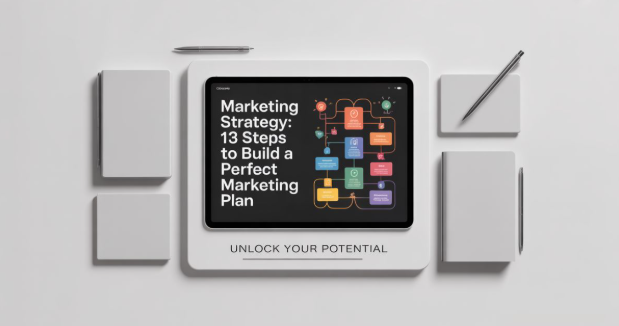
Developing a marketing plan isn’t just slapping some ads or posts up randomly on social media. It’s also about doing the work to map business goals to concrete, measurable objectives and putting them into a strategic action plan.
Get it right, and a digital marketing strategy can help you pinpoint your most motivated buyers, multiply your sales, and secure your place as a force to be reckoned with into the future.
Consider your plan your road map. Instead of stabbing in the dark to determine what to do next, you’ll know exactly what your path toward growth requires, backed by research, creativity, and data-informed decisions.
Now, let’s go through the 13 steps involved in any powerful marketing strategy.
1. Determine Your Marketing Objectives
Determine Your Marketing Objectives. There are several steps to follow on the path to turning things around. The first, and arguably the most important, is to know exactly what you want to accomplish with your marketing plan. Are you looking to
Increase brand awareness?
Generate more qualified leads?
Drive higher sales?
Clear goals assist in keeping the squad on the right path and also focused. You may, for example, set yourself a goal of growing your email subscriber list by 20% over the next six months. These Ideals are like the guiding north star. Such strategies, however brilliant, might not take you where you need to go without them. It might be more visits to the website, higher conversions, increased customer participation, etc, but having some values in mind will keep you on the right path.
2. Research Your Competition
After you’ve established goals, your next step is to study the competition. In marketing, a competitive analysis can tell you what does and doesn’t work in your industry, and where you can differentiate yourself.
Briefly consider their pros and cons, tactics, and strategies. Business analysis techniques such as SWOT analysis can help you determine market loopholes.
So, if your competitor is killing it on social media but not doing that well on email marketing, THIS is your space to shine! Keep in mind, competitor research is not about copying– it’s about finding smarter ways you can make yourself more easily known.
3. Formulate a Plan of Marketing Attack
Now that you know your goals and know the competition, it’s time to construct a clear marketing plan of action
This plan should outline:
The steps you’ll take
The resources you’ll need
Break down your plan into more manageable blocks. A plan could look like content production, social media promotion, paid advertising, and email marketing if your big goal is releasing a product, for example.
It keeps your group motivated and on track, so that you can monitor how you’re doing (and correct course when you’re not) and scale up confidently.
4. Research Your Target Audience
There are no successful marketing efforts that are not built on who you’re trying to reach. This is where target audience research and buyer’s persona are born. Identify your ideal customers:
Age
Interests
Pain point
Purchasing habits
Think about it as a conversation; if you don’t know what the other person cares about, they will tune you out fast. The creation of more fleshed-out personas means you can target your campaigns more closely, enhance the customer experience, and engage with motivated buyers who are ready to buy.
5. Develop a Plan That is Consistent with Your Goals and Audience
When you know who you are writing for, customize your goals to a unique digital marketing plan. Remember, strategy is not one-size-fits-all. The way a local baking company will go about forming one will be the polar opposite of a SaaS startup
If you’re focusing so much time on LinkedIn ads when your ideal customer spends most of their time on Instagram, the bigger part of the sales funnel isn’t being optimized.
Because the smartest marketing is one that blends creativity and data, it makes sure that every move brings you closer to your goals.
6. Choose the Right Marketing Channels
Your selection of marketing channels can either destroy or make your results.
Digital channels: Organic search, social media, email, paid advertising
Relrydah Articles Do it, iterate, and see if you’re ever in the position to benefit from so much the better. Offline touchpoints– events, print, sponsorships
The key is balance. Rather than attempting to be all things to all people, concentrate on the platforms your audience is using.
Lifestyle brands tend to do well with social media marketing strategies. B2B organizations tend to do better with LinkedIn and email marketing when they use best practices.
7. Create Effective Marketing Materials
With channels in place, prepare the tools that will carry your message.
Effective marketing materials might include:
- Blog posts and videos
- Email templates and brochures
- Case studies and sales presentations
They should read well, be professional, and reflect the “voice” of your brand. Strong content marketing supported by visuals and testimonials establishes trust and pushes potential buyers down the funnel.
8. Implement Your Marketing Strategy
Now comes execution. This is where planning turns into action.
Implementation may include:
- Running a paid advertising strategy
- Launching social media campaigns
- Sending automated email sequences
- Publishing SEO-optimized blog content
Think of this as your business “performance.” The planning was rehearsal; now it’s time to deliver results. When your team is in sync, your business growth strategy gains momentum.
9. Measure Your Results
You cannot improve what you do not measure. Results tracking makes sure your marketing efforts are worth it.
Use KPIs such as:
- Website traffic
- Conversion rates
- Customer engagement
l it’s easy to see what’s working using tools like Google Analytics or even marketing dashboards.
You may need conversion rate optimization (CRO) if, for example, you’re getting traffic but no sales. The purpose of learning results isn’t data collection, but rather smarter decisions informed by evidence.
10. Evaluate and Adjust as Needed
Marketing is never just “set it and forget it. Once you measure results, you’ll likely find areas to improve. Adjusting marketing tactics could mean:
- Tweaking ad copy
- Testing new headlines
- Changing your email frequency
11. Think about fine-tuning a machine.
Read More Sometimes it’s the small things that matter most. The best marketers see change as an invitation to innovation.
Keep your strategy fresh. Markets are changing, trends are changing, people are changing
Your business plan will need to change. Not so long ago, most marketers didn’t have TikTok on their radar. Today, it has become an essential means of reaching young viewers. For that, you will remain competitive, and you present the brand as forward-looking when you do everything to keep your strategy up to date.
12. Don’t Get Complicated, Keep Your Eye on the Prize
It’s easy to get lost, with so many tools and tactics to choose from. But here’s the thing: You don’t have to do any of that.
Focus on a few of these high-ROI tactics that work for your goals and audience. Quality beats quantity every time.
Long-term results can also be substantial from small, consistent steps — such as weekly blog posts or monthly email campaigns.
13. Get Help When Needed
The smartest thing to do sometimes is to ask for help. If you have either marketing consultants, outsourcing SEO, or are engaging an agency for lead generation strategies, then you are on the fast track. Asking for help isn’t a sign that you’re not cutting it — it’s a sign that you’re serious about expansion.
FAQs
1. What is the Marketing strategy used for?
A marketing strategy provides your business with direction. It bridges your goals and practical steps on how to get to the right audience, increase your sales, and grow sustainably.
2. What is the difference between a marketing strategy and a marketing plan?
A strategy is the “big picture your overarching plan and trajectory. A marketing plan is more tactical and is a detailed list of the campaigns, timelines, and ways the strategy will be executed.
3. How often should I refresh my marketing plan?
At least once a year. But if your industry or your customer’s behavior is changing rapidly, re-examine variables and adjust them quarterly to remain competitive.
4. I don’t have a large business why should I be concerned with a marketing strategy?
Absolutely. Well-planned planning process makes small businesses get the best out of their resources. You don’t need to leave the store with much, but even a simple plan can ensure you’re targeting the right people and not wasting your money.
5. What are some marketing channels I could leverage?
The usual channels to consider can be divided into the following: social media, SEO, email marketing, paid ads, events, and offline, which involves brochures and sponsorships. In the end, it simply also depends on where your potential readers will reside.
Conclusion:
You just don’t know where to begin since you don’t even have a marketing plan! Begin with important goals and understand your audience and which channels work, and just keep at it, and you have a strategy that drives real growth. And always remember: No plan is ever finished.
It scales as your business, customers, and the market grow. Stay open to learning, never stop learning, and don’t be afraid to ask for help. Toss in some pluck and wise decisions, and your marketing will be more than a marketing plan, it’s going to be a play for the future of your firm
.




